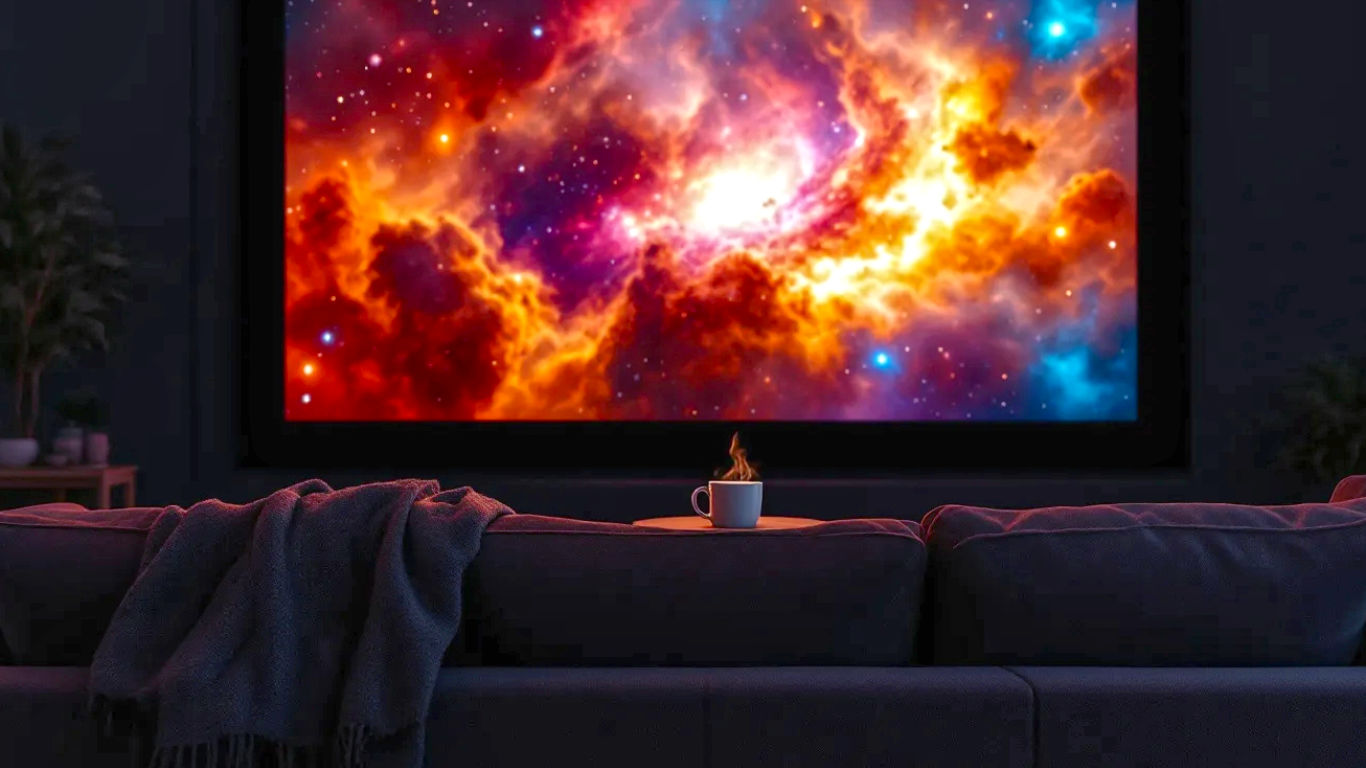Home Cinema Nirvana: The Ultimate British Guide to Creating a Cinematic Experience at Home
Unlock the ultimate cinematic experience. Our complete guide covers everything a UK enthusiast needs to know about TVs, sound systems, and room setup.

This post may contain affiliate links. If you make a purchase through these links, we may earn a commission at no additional cost to you.
There’s a certain magic to the cinema, isn’t there? The moment the lights dim, the rustle of popcorn bags quietens, and the screen flickers to life with a sound that you don’t just hear, but feel in your chest. For decades, that experience was a special trip out. But today, bringing that blockbuster magic into your own home isn’t just a dream for millionaires with dedicated basements. It’s something you can achieve, whether you’re in a Glasgow flat, a semi-detached in Surrey, or a cottage in the Cotswolds.
This isn’t just about getting a bigger telly. It’s about crafting an experience. It’s about being so completely pulled into a story that you forget you’re on your own sofa. It’s about hearing the TIE fighters scream past you in Star Wars, feeling the rumble of the Batmobile, and hearing every whispered secret in a tense drama as if you’re right there in the room.
This is your ultimate guide to doing just that. We’ll cut through the jargon, sidestep the costly mistakes, and walk you through everything you need to know to build a home cinema that will make your friends and family utterly speechless. So, grab a cup of tea, get comfy, and let’s begin.
The Two Pillars of Home Cinema: A Grand Picture and Glorious Sound
Before we dive into the nuts and bolts, let’s simplify things. A truly cinematic experience boils down to two fundamental things:
- A big, beautiful picture that fills your vision. It needs to be detailed, vibrant, and large enough to draw you in completely.
- Immersive, dynamic sound that comes from all around you. It needs to place you in the middle of the action, not just in front of it.
Think of it like a West End show. The screen is the stage, and the actors are delivering their lines. The sound system is the entire theatre around you: the orchestra, the atmospheric effects, the sense of space and place. Get both of these pillars right, and you’re well on your way to home cinema nirvana. Everything else—the comfy seats, the smart lighting, the popcorn machine—is the wonderful window dressing.
Pillar One: The Visuals – Choosing Your Window to Other Worlds
The first thing that hits you in a real cinema is the sheer scale of the screen. Replicating that impact is your first goal. Your choice here is the biggest fork in the road: do you go for a massive television or a projector and screen?
Television vs. Projector: The Great Debate
This is the foundational question, and there’s no single right answer. It depends entirely on your room, your budget, and how you’ll be using it.
Team Television: A modern large-screen TV is the simplest, most versatile option.
- Pros: They work brilliantly in bright rooms, making them perfect for living rooms where you can’t always achieve total darkness. The picture quality, especially on premium models, is stunning, with incredible contrast and vibrant colours. They’re also a doddle to set up and are great for everyday watching, from the news to The Great British Bake Off.
- Cons: You pay a hefty price for size. A 75-inch TV is a serious investment, and an 85-inch one can cost as much as a small car. Beyond that size, you’re entering a world of eye-watering expense. While big, it might not quite capture that wall-filling cinema scale.
Team Projector: For the ultimate in cinematic scale, nothing beats a projector.
- Pros: Size, size, and more size. You can easily achieve a 100-inch, 120-inch, or even larger image for a fraction of the cost of a similarly sized TV. This is what truly replicates the commercial cinema feel. When the lights go down, the experience is simply unbeatable.
- Cons: They demand darkness. A projector is fighting against any other light in the room, so you’ll need good blackout blinds or curtains. They’re more involved to set up (mounting, focusing, aligning), and you’ll need a separate screen and, of course, a sound system (as they have no meaningful speakers). The bulbs also have a limited lifespan, though modern laser projectors last for years.
The Verdict? If your system is going in a multi-purpose living room and will be used during the day, a large TV is probably the more practical choice. If you have a dedicated room or a space you can easily make pitch-black, a projector will give you the most authentic and immersive cinematic experience.
If You Choose a TV: A Guide to the Alphabet Soup
The world of TVs is swimming in acronyms. Here’s a simple breakdown of the main technologies you’ll see in the aisles of John Lewis or on the Richer Sounds website.
- OLED (Organic Light Emitting Diode): Think of an OLED screen as having millions of tiny, individual lightbulbs that can turn on and off completely. This means they can produce perfect black. When a part of the screen is black, it’s truly black, not just a dark grey. This gives OLEDs phenomenal contrast and incredibly vivid, lifelike images. They’re fantastic for watching films in a dark room. Their main drawback is they aren’t quite as bright as the competition and there’s a small, theoretical risk of screen burn-in (though it’s very rare with normal use).
- QLED & Neo QLED (Quantum Dot Light Emitting Diode): This is a technology championed by Samsung, but used by other brands too. It’s a super-advanced version of a standard LED TV. It uses a layer of “quantum dots” to produce more vibrant and accurate colours. QLEDs are known for being incredibly bright, which makes them punchy and brilliant for watching in bright rooms. Neo QLED is the newer version, which uses thousands of tiny “Mini LEDs” for its backlight, allowing for much more precise control over which parts of the screen are bright and which are dark, getting them closer to OLED-like contrast.
- Mini LED: This isn’t a screen type itself, but a backlight technology used in QLED and other high-end LED TVs. As mentioned, it uses thousands of tiny LEDs instead of a few dozen larger ones. The result is better contrast, less “blooming” (where light bleeds from bright objects into dark areas), and a picture that gets very close to the quality of an OLED.
If You Choose a Projector: Painting with Light
Projectors feel a bit more old-school and technical, but modern ones are remarkably user-friendly. The main things to consider are:
- Throw Distance: This is simply how far away the projector needs to be from the screen to create a certain sized image. A “short-throw” projector can create a huge image from just a few feet away, which is great for smaller British living rooms. An “ultra-short-throw” (UST) projector is a marvel of optics—it sits right underneath the screen on a media unit, looking much like a soundbar.
- Lumens: This is a measure of brightness. The higher the lumens, the better the projector can compete with ambient light. For a dedicated dark room, 2,000 lumens is plenty. For a room with some low light, you’ll want to look for 3,000 or more.
- The Screen: Don’t just project onto a white wall! A proper screen is designed to reflect light back at you evenly and accurately. You can get fixed-frame screens that hang like a painting, or electric retractable screens that disappear at the touch of a button. For rooms with some light, an “Ambient Light Rejecting” (ALR) screen can work wonders by reflecting the projector’s light forward while absorbing light from other angles.
Essential Visual Jargon, Demystified
Whatever you choose, you’ll see these terms everywhere. They’re more important than the screen technology itself.
- Resolution (4K vs. 8K): This is the number of pixels (tiny dots) that make up the picture. For years, Full HD (1080p) was the standard. Now, 4K (or Ultra HD) is the king. It has four times the pixels of HD, resulting in a much sharper, more detailed, and more lifelike image. It’s the current sweet spot for quality and content availability. 8K is the next step up, but honestly, for most screen sizes and viewing distances, you won’t notice a huge difference, and there’s very little 8K content to watch. Stick with 4K; it’s brilliant.
- HDR (High Dynamic Range): If 4K is about adding more pixels, HDR is about making each pixel better. It’s a game-changer for picture quality. HDR allows for a much wider range of brightness and colour. It means you can see the bright glint of the sun on a car bonnet and, at the same time, the subtle details lurking in the dark shadows of a nearby alley. It makes the picture pop in a way that’s much closer to how our eyes see the real world. You’ll see different “flavours” of HDR, like HDR10, HLG (used for broadcasting by the BBC), and the more advanced Dolby Vision, which adjusts the picture scene by scene.
Pillar Two: The Audio – Feeling Every Moment
A stunning picture is only half the story. It’s the sound that truly sells the illusion. It transforms a movie from something you watch into something you experience.
Why Your TV’s Speakers Just Won’t Cut It
Let’s be honest, the speakers built into your wafer-thin telly are, to put it mildly, a bit rubbish. They’re tiny, often face downwards or backwards, and simply can’t move enough air to create powerful, dynamic sound. To get cinematic sound, you need a separate audio system. A soundbar is a massive step up, but for the true home cinema experience, you need a proper surround sound system made up of an AV receiver and multiple speakers.
Decoding Surround Sound: From 5.1 to the Skies Above
The goal of surround sound is to create a 3D “bubble” of sound with you sitting right in the middle. The numbers you see (like 5.1 or 7.2.4) simply refer to the number and type of speakers.
- 5.1 (The Classic): This has been the standard for decades and is a fantastic starting point. It consists of three speakers at the front (left, centre, right), two “surround” speakers to the side or slightly behind you, and a .1 for the subwoofer, which handles the deep bass.
- 7.1 (More Immersion): This adds two extra speakers that go directly behind you. This creates a more seamless and enveloping sound field, especially for effects that move from front to back.
- Dolby Atmos & DTS:X (The Game-Changers): This is where things get really exciting. These are “object-based” audio formats. Instead of just sending sound to specific channels, they can place individual sounds (like a bee buzzing or a helicopter flying) precisely in a 3D space around you. To do this, they add height channels. So, a 5.1.2 system is a classic 5.1 setup with two extra speakers for height effects, either mounted in the ceiling or as upward-firing units on top of your existing speakers. A 7.1.4 system would have four height speakers. Hearing rain that genuinely sounds like it’s coming from your ceiling is a “wow” moment you won’t forget.
The Cast of Your Audio System
A surround sound system has a few key players, all working together.
- The AV Receiver (AVR): The Brains of the Operation. The AV Receiver is the central hub of your entire system. Everything plugs into it: your Sky box, PlayStation, Blu-ray player, and TV. It does three crucial jobs:
- It lets you switch between your different sources.
- It decodes the surround sound formats from your movies and games.
- It amplifies the signal and sends it to the correct speaker. This is arguably the most important component, so it pays to get a good one. Look for models that support 4K, HDR, Dolby Atmos, and DTS:X to ensure you’re future-proof.
- The Speakers: Your Orchestra. Each speaker has a specific role to play.
- Front Left & Right: These set the soundstage and handle most of the music and primary sound effects. They can be large floorstanding speakers or smaller bookshelf speakers on stands.
- Centre Speaker: This is the unsung hero. It handles almost all of the dialogue. A good centre speaker ensures voices are crystal clear and locked to the screen, even when chaos is erupting all around.
- Surround & Rear Speakers: These are for ambience and effects. They’re what make you duck when a bullet whizzes past your ear.
- Height Speakers: The Atmos/DTS:X speakers that provide the overhead sound.
- The Subwoofer: The Rumble in the Jungle. The subwoofer (the “.1”) is a specialised speaker designed to do one thing: produce deep, low-frequency bass. It’s not just for explosions. It adds weight and scale to everything, from the thrum of a spaceship’s engine to the ominous score in a horror film. A good subwoofer provides tight, controlled bass you can feel, not just a boomy, one-note rumble. Some people even add a second one (making it a 5.2 or 7.2 system) for more even bass throughout the room.
The Unsung Hero: The Room Itself
You can buy the best, most expensive equipment in the world, but if you put it in a room with terrible acoustics and layout, it will sound and look disappointing. The room is the final, and most often overlooked, component of your system.
Finding the Sweet Spot: Seating and Layout
The first rule of home cinema is that not all seats are created equal. There is an optimal viewing and listening position, often called the “sweet spot”. Your main seating position should be directly opposite the centre of the screen and roughly in the middle of all your speakers. Try to arrange your main sofa or chairs here.
For screen size, a good rule of thumb is the THX recommendation: take the diagonal size of your screen and multiply it by 0.84 to get the recommended viewing distance. So for a 100-inch screen, you’d want to sit about 84 inches (7 feet) away. This ensures the screen fills your field of view without you having to turn your head.
Taming the Sound: An Introduction to Room Acoustics
Sound waves are like bouncy balls. In an empty room with hard surfaces (wooden floors, bare walls, large windows), sound will bounce around all over the place, creating echo and making everything sound muddy and unclear. This is bad acoustics. The goal is to control those reflections.
It’s important to understand Soundproofing vs. Acoustic Treatment.
- Soundproofing is about stopping sound from getting in or out of the room (e.g., stopping your movie from annoying the neighbours). This is difficult and often involves structural changes like building a room-within-a-room.
- Acoustic Treatment is about controlling the sound inside the room to make it sound better. This is much easier and more important for most people.
You can dramatically improve your room’s acoustics with simple, décor-friendly additions:
- A thick rug on a hard floor.
- Heavy curtains over windows.
- A fabric sofa instead of a leather one.
- Bookcases filled with books (their irregular shapes are great at breaking up sound waves).
For those wanting to go a step further, dedicated acoustic panels can be placed at key reflection points on the walls and ceiling. These are fabric-covered panels that absorb sound, tightening up the bass and improving clarity.
Let There Be (No) Light: Mastering Cinema Lighting
To get the best picture, especially from a projector, you need to control the light.
- Blackout blinds or curtains are a must. They are the single best investment for improving your picture’s contrast.
- Paint your room a dark, neutral colour. If you have a dedicated room, painting the walls (and even the ceiling) a dark grey, navy, or burgundy will stop light from the screen reflecting back and washing out the image.
- Consider bias lighting. This is a soft, neutral light (a simple LED strip) placed behind your TV. It seems counter-intuitive, but it actually makes the perceived contrast of the screen better and reduces eye strain when watching in a dark room.
Putting It All Together: A Practical Step-by-Step Guide
So you’ve got the concepts down. How do you actually build it?
Step 1: Plan and Budget – Measure Twice, Buy Once
Decide on a realistic budget. You can put together a fantastic entry-level system for under £2,000, while a high-performance mid-range setup might be closer to £5,000-£10,000. The sky is the limit from there. Measure your room carefully. Know your viewing distance. This will determine the ideal screen size and speaker placement. Plan where everything will go.
Step 2: Running the Wires – The Cable Conundrum
This is the least glamorous part, but it’s vital. You’ll need to run speaker wire from the AV receiver to every single speaker, plus HDMI cables from your sources to the receiver and from the receiver to the screen. Plan the routes. You can hide cables under rugs, use trunking that sticks to your skirting boards, or, for the cleanest look, run them behind the walls or under the floorboards (this may require a professional).
Step 3: Placement Perfection – Setting the Stage
Speaker placement is crucial for creating a convincing sound field. Dolby provides detailed guides, but here are the basics for a 5.1 setup:
- Centre Speaker: Directly below or above the screen, angled at your ear level.
- Front Left/Right: Placed on either side of the screen, forming an equilateral triangle with your seating position. “Toe” them in slightly so they point directly at you.
- Surround Left/Right: Placed to the direct sides of, or slightly behind, your seating position, just above ear level.
- Subwoofer: This is less critical, as deep bass is hard to localise. The corner of the room is a common spot, but it can make the bass boomy. Try moving it around while listening to a bass-heavy scene—this is called the “subwoofer crawl”—to find where it sounds best.
Step 4: Calibration – Tuning Your System for Peak Performance
Once everything is plugged in, it’s time to tune it.
- Audio Calibration: Nearly all modern AV receivers come with a microphone and an automatic calibration system (like Audyssey, Dirac Live, or YPAO). You place the microphone at your main listening position, and the receiver sends test tones to each speaker. It then automatically sets the speaker distances, levels, and applies equalisation (EQ) to correct for your room’s acoustic problems. Do not skip this step! It’s the single most important thing you can do to make your system sound its best.
- Video Calibration: Most TVs have a “Cinema” or “Filmmaker Mode”. Use it. These modes are designed to show the movie exactly as the director intended, with accurate colours and no weird motion-smoothing effects (which you should always turn off for films).
Common Pitfalls to Avoid on Your Home Cinema Journey
- Buying a “Home-Theatre-in-a-Box”: These all-in-one systems seem like a bargain, but they often use proprietary connections and feature underpowered receivers and cheap, tiny speakers. You’re much better off buying separate components, even if you start small and build up over time.
- Ignoring the Centre Speaker: People often spend a fortune on big front speakers and then skimp on the centre. This is a huge mistake, as it’s responsible for dialogue clarity.
- Screen Too High: A classic error, often seen when mounting a TV above a fireplace. Your screen should be at eye-level when you’re seated. Looking up for two hours is a recipe for neck pain.
- Forgetting About the Room: As we’ve discussed, even the best gear will sound bad in a terrible room. A few hundred pounds spent on a thick rug and heavy curtains can make a bigger difference than thousands spent on a speaker upgrade.
The Future of Home Cinema: What’s on the Horizon?
The technology never stands still. We’re already seeing 8K becoming more common, though its real-world benefit is debatable for now. MicroLED technology, which has all the benefits of OLED with even higher brightness and no burn-in risk, is on the horizon but is currently astronomically expensive. On the audio front, we’ll likely see more advanced, AI-driven room correction and more seamless integration of high-quality wireless speaker technology, finally freeing us from the tyranny of cables.
Conclusion: Your Personal Box Office Awaits
Building a home cinema can seem daunting. It’s a world filled with technical terms, endless options, and passionate debates on internet forums. But at its heart, it’s simple. It’s about chasing that feeling you get when the lights go down and you’re transported to another world.
It’s a journey, not a destination. Start with a solid foundation—a good 4K screen and a decent AV receiver and speaker package. Treat your room as a vital component. And most importantly, have fun. The goal isn’t to have the most expensive system; it’s to have a system that makes you want to rediscover your favourite films and experience new ones in the most immersive way possible.
Your private cinema is waiting. All you have to do is build it. Curtain up.
Further Reading
For those who wish to delve deeper, these resources are highly respected in the industry and provide a wealth of trusted reviews, guides, and community discussions:
- What Hi-Fi?: https://www.whathifi.com/ – A cornerstone of the British hi-fi and AV scene for decades, offering expert reviews and advice.
- AVForums: https://www.avforums.com/ – An incredibly active and knowledgeable UK-based community for home cinema and audio-visual enthusiasts.
- Richer Sounds VIP Club: https://www.richersounds.com/vip-club – The blog and guides from this popular UK retailer are full of accessible, practical advice.
- Dolby Professional: https://professional.dolby.com/ – For those who want the technical details straight from the source, including speaker setup guides.
- THX: https://www.thx.com/ – The original home cinema certification body, with excellent articles on best practices and standards.






